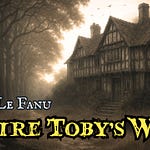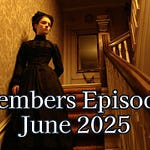Joseph Sheridan Le Fanu
Le Fanu was an Irish writer born in Dublin in 1814 and who died in Dublin in 1873. In his time he was the leading writer of ghost stories and macabre tales.
On the podcast, we have read out his masterwork, Carmilla, but Green Tea is an equally well-known story.
He was judged by the master ghost story writer of a later generation, M R James as being absolutely first rank.
His family were of French protestant (who fled France because of persecution) and English descent. His family were writers, and his grandmother Alice Sheridan Le Fanu and his great-uncle Richard Brinsley Sheridan were famous playwrights. His mother was a writer of biographies.
Le Fanu’s father was a protestant clergyman in the Church of Ireland. He was a rector of a protestant church in Ireland and the family were disturbed by the 1830s Tithe War where the majority Catholic population objected to paying tithes to the Protestant minority church.
Le Fanu studied law at Trinity but as early as 1839 (when he was twenty-four) he wrote ghost stories for the Dublin newspapers.
In 1847 Le Fanu was active in the campaign against the cruel indifference of the British government which did little to relieve the suffering during the Irish famine.
Le Fanu’s wife had significant mental health problems and his married life was less than happy. He wrote ghost stories set in Ireland, but due to the influence of his publisher, began to write stories with an English setting because they felt they would sell better.
He died of a heart attack in Dublin aged only 58.
Green Tea
Le Fanu produced a collection of supernatural stories called In A Glass Darkly which was published in 1872. This was ostensibly the collected papers of the occult German medical-philosopher Dr Hesselius. Think of Sherlock Holmes cases ostensibly recorded by Dr Watson.
There is little doubt that no publisher would look at Green Tea now. It is full of ‘telling’ rather than showing. Most of the action happens at third hard. There are frames to the story: it is edited by the editor who got the papers at the death of a professor and much concerns Hesselius’s reports of things he has heard.
There are philosophical ramblings about Swedenborg’s metaphysics which are of very little interest to the modern reader. However, we know these things were of intense interest to Le Fanu and possibly to his contemporaries.
It does introduce Swedenborg’s idea that a man can be conjoined with an evil spirit, however. Sometimes these evil spirits, or even two evil spirits, take animal form. Hint. hint.
Le Fanu does dialogue well and the dialogue was smooth to narrate and quite naturalistic.
It is quite unclear whether the story reports an actual haunting by a devil monkey or a psychosis.
Hesselius diagnoses the end as a hereditary suicidal mania. I’m not sure we believe such things are heritable, though suicide can run in families, though more likely through a nurture rather than nature cause. But who knows?
The story that asks: was it madness or was it a monster? Has a strong pedigree. On The Classic Ghost Stories Podcast we have read The Horla by Guy de Maupassant and The Yellow Wallpaper by Charlotte Perkins-Gilman both of which can be interpreted either way.
I was recently reading the critic Mark Fisher’s book The Weird and The Eerie in which he draws a distinction between weird and eerie elements (and also uncanny components) of a story.
The ‘weird’ Fisher says is about the juxtaposition of the normal with things that should not be there. The devil monkey is therefore distinctly weird. He talks about how this juxtaposition, as beloved by the surrealists later, can lead to an unsettling of sanity.
My own view of this would be that the unknown provokes anxiety and the inability to map the new element into an existing world view can produce so much anxiety that it can trip up into a psychosis.
Fisher defines the eerie as doing with agency. When the reason that something is done, its agency, is mysterious: the eerie remains of Stonehenge, the eerie cry of a bird, the eerie empty landscape, then that is different from the weird.
In this case the eerie comes from us wondering about the agency of the monkey. What is it? What does it want? Why does it torment him? We get tentative answers to these questions, but nothing conclusive.
When the Rev. Jennings begins his account of the monkey, he starts by setting out the theological project he was engaged in and talks about the depth of study and the nature of the study: paganism both as contributors to his nervous affliction.
Hesselius then talks about the use of stimulants to fuel the student in his late night work. Incidentally, my mother reports the regular use of amphetamine by nurses on night shift at the Royal Infirmary Edinburgh in the 1950s, before it was illegal.
It is interesting that Green Tea is considered now an innocuous and gentle drink, beloved by Yoga teachers, but to Hesselius it is the very devil’s brew and dangerous to the nerves.
The descriptions of the monkey are pretty good, as when it sits on the wall, hands on its knees observing him sulkily.
The monkey is distinctly visible in total darkness, indicating its mental nature, I think.
I can’t explain the absences that are always over a fortnight. That doesn’t sound like a psychosis,
The monkey really seems to despise him when he is carrying out holy office This suggests its nature as an evil spirit.
The fact that when it learns to speak it interrupts him while he is praying also supports this view.
Its starts commanding him. These probably would be called command hallucinations these days, and a bad sign indeed.
The monkey always urges him to crimes, to injure others, and to injure himself. This is very common in mental illness these days. Not necessarily in psychosis because we also see this, probably se it more in Borderline Personality Disorder.
It urged him to jump down an old mineshaft. As well as being a symptom of mental illness, it is a bit of literary foreshadowing and leads us to go “of course!” When we find out that Jennings has made away with himself.
Because he’d flagged this up beforehand.
I see an interesting point in a review on the internet by Charlotte Spivack that reminds us that gothic fiction was interested in the projection of the vile components of a person onto a hideous companion. The prime example is Dr Jekyll & Mr Hyde, but also we could consider Dr Frankenstein and his monster or Rev. Jennings and the monkey.
In the last part of the story, Hesselius propounds his theory of a nervous fluid analogous to the circulation of the blood, where the brain is the pump for this nervous fluid which he considers is spiritual in nature, but physical enough to travel through nerves as the blood travels through arteries and veins. He even thinks there is an arterial and venous component.
He sees this nerve fluid as being similar to electricity or light more than blood, so not physical, but energetic though he doesn’t use that idea.
This is similar to the Chinese idea of qi, a bioenergy that permeates the body and whose correct flow is essential for good health.
Green Tea can negatively effect the nervous fluid. He also hints that disembodied spirits can have an influence on the flow of this nervous fluid, and so we never establish whether the monkey was real or a figment of Jenning’s imagination only.
He also talks about the eye of this system being above the eyebrows, so in the region of the Third Eye of the Indian Chakra system.
It can be helped the application of iced eau de cologne, which is of course a spirit.
If Hesselius had sealed this inner eye, Jennings would have been cured of seeing the monkey.
Some modern critics lambast the Frame and the end explanatory sequence, but probably unfairly. Le Fanu was a mid-Victorian. He hadn’t done an MA in Creative Writing.
His purposes and his audiences weren’t the same as ours and it’s unfair to judge this story by the requirements of modern readers. Mid-Victorians wanted something different as Le Fanu’s success shows.
If You Appreciate The Work I’ve Put In Here
Or buy me a coffee , if you’d like to keep me working.
Music by The Heartwood Institute














Share this post